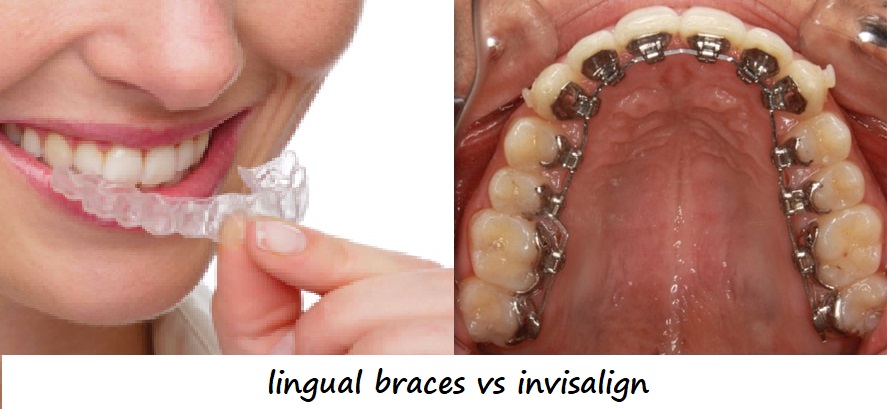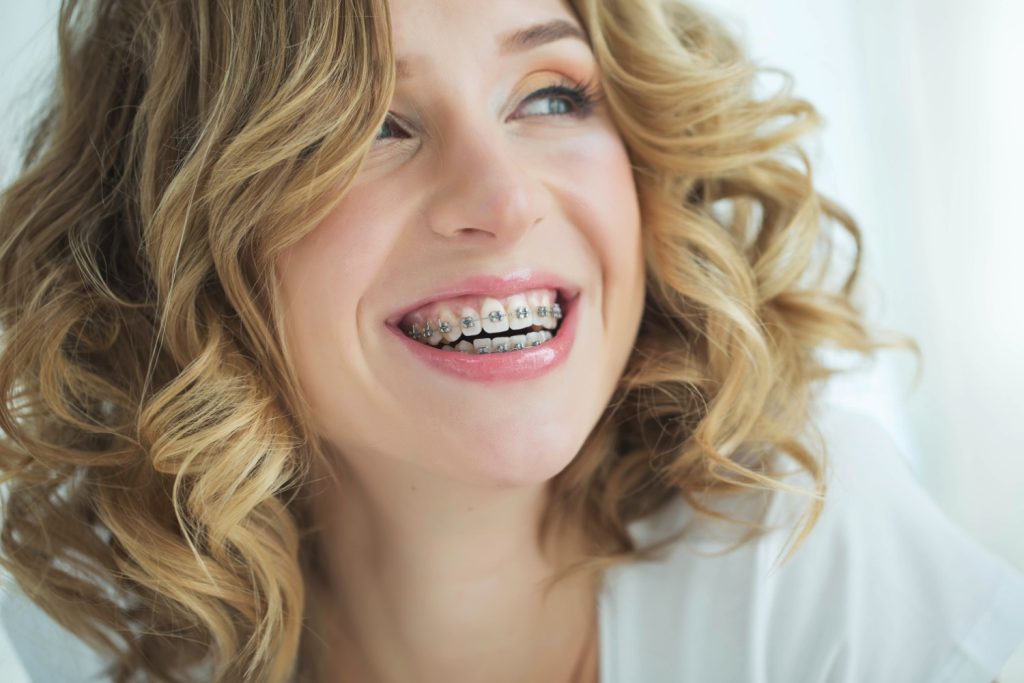Lingual braces vs invisalign

Orthodontic treatment has evolved significantly, offering various options to cater to different needs and preferences. Two popular alternatives for achieving a straighter smile are lingual braces and Invisalign. Each has its unique advantages and drawbacks, making it essential to understand both to make an informed decision. This comprehensive guide will delve into the differences, benefits, and considerations of lingual braces vs. Invisalign, helping you choose the best option for your orthodontic needs.
What Are Lingual Braces?
Lingual braces are a type of orthodontic treatment where the braces are attached to the back (lingual side) of the teeth, making them virtually invisible from the front. They function similarly to traditional metal braces, using brackets and wires to gradually move the teeth into the desired position.
Key Features of Lingual Braces
- Invisibility: Since lingual braces are placed behind the teeth, they are not visible when you smile, speak, or interact with others.
- Customization: Each bracket is custom-made to fit the shape of your teeth, ensuring a precise and effective treatment.
- Effectiveness: Lingual braces can correct a wide range of orthodontic issues, from minor misalignments to more complex cases.
What Is Invisalign?
Invisalign is a brand of clear aligners, which are transparent, removable trays that fit snugly over your teeth. Invisalign aligners are made from a smooth, BPA-free plastic and are custom-designed for each patient using 3D imaging technology.
Key Features of Invisalign
- Transparency: Invisalign aligners are clear and almost invisible, making them an attractive option for those who prefer a discreet treatment.
- Removability: Aligners can be removed for eating, drinking, brushing, and flossing, offering convenience and flexibility.
- Comfort: Made from smooth plastic, Invisalign aligners are generally more comfortable and less likely to irritate the gums and cheeks compared to traditional braces.
Comparing Lingual Braces vs. Invisalign
1. Aesthetics
Lingual Braces: Completely invisible from the front, lingual braces are ideal for those who want a discreet treatment. They are hidden behind the teeth, ensuring no visible metal or brackets when you smile.
Invisalign: Invisalign aligners are nearly invisible, making them a popular choice for those seeking an aesthetic solution. However, they can be slightly noticeable up close or in certain lighting conditions.
2. Comfort
Lingual Braces: Lingual braces may cause initial discomfort and irritation to the tongue due to their placement behind the teeth. It can take some time to get used to the feeling of the brackets and wires.
Invisalign: Invisalign aligners are smooth and generally more comfortable. They do not have brackets or wires that can cause irritation, making them a more comfortable option for many patients.
3. Effectiveness
Lingual Braces: Lingual braces are highly effective for treating a wide range of orthodontic issues, including complex cases of misalignment, crowding, and bite problems. They offer precise control over tooth movement.
Invisalign: Invisalign is effective for treating mild to moderate orthodontic issues. While advancements in technology have expanded the range of cases Invisalign can address, it may not be suitable for very complex orthodontic problems.
4. Treatment Duration
Lingual Braces: Treatment duration with lingual braces is similar to traditional braces and depends on the complexity of the case. On average, treatment can last from 18 months to 3 years.
Invisalign: Invisalign treatment duration varies based on the severity of the case, typically ranging from 6 months to 18 months for most patients.
5. Maintenance and Oral Hygiene
Lingual Braces: Maintaining oral hygiene with lingual braces can be challenging due to their placement. Special tools like interdental brushes and floss threaders are needed to clean around the brackets and wires effectively.
Invisalign: Invisalign aligners can be removed for brushing and flossing, making it easier to maintain good oral hygiene. It is essential to clean the aligners regularly and follow a strict oral care routine.
6. Eating and Dietary Restrictions
Lingual Braces: Similar to traditional braces, lingual braces come with dietary restrictions. Hard, sticky, and chewy foods should be avoided to prevent damage to the brackets and wires.
Invisalign: Invisalign aligners are removable, allowing you to eat and drink without restrictions. However, it is crucial to brush your teeth before reinserting the aligners to prevent staining and cavities.
7. Speech Impact
Lingual Braces: Lingual braces can affect speech initially, causing a temporary lisp or difficulty in pronouncing certain sounds. Most patients adapt within a few weeks as they get used to the braces.
Invisalign: Invisalign aligners may cause minor speech changes, but these typically resolve quickly as patients adjust to wearing them.
8. Cost
Lingual Braces: Lingual braces are often more expensive than traditional braces and Invisalign due to their customization and the expertise required for placement. Costs can vary widely based on the complexity of the case and the orthodontist’s fees.
Invisalign: Invisalign can be comparable in cost to traditional braces but may vary depending on the treatment plan and the number of aligners required. Financing options and insurance coverage can help manage costs.
Pros and Cons of Lingual Braces
Pros
- Invisible from the Front: Ideal for those who want a discreet orthodontic treatment.
- Effective for Complex Cases: Can address a wide range of orthodontic issues.
- Customizable: Each bracket is tailored to the patient’s teeth for precise treatment.
Cons
- Initial Discomfort: Can cause tongue irritation and take time to get used to.
- Maintenance Challenges: Oral hygiene requires extra effort and special tools.
- Higher Cost: Generally more expensive due to customization and expertise required.
Pros and Cons of Invisalign
Pros
- Nearly Invisible: Clear aligners are discreet and aesthetically pleasing.
- Removable: Allows for easy eating, drinking, and oral hygiene.
- Comfortable: Smooth plastic aligners are gentle on the gums and cheeks.
Cons
- Not Suitable for Complex Cases: May not be effective for severe orthodontic issues.
- Requires Discipline: Must be worn 20-22 hours a day for effective treatment.
- Potential for Misplacement: Removable aligners can be lost or damaged if not handled properly.
Choosing Between Lingual Braces vs. Invisalign
The decision between lingual braces and Invisalign ultimately depends on your specific orthodontic needs, lifestyle, and personal preferences. Here are some factors to consider:
Severity of Orthodontic Issues
- Complex Cases: Lingual braces are generally better suited for more complex orthodontic issues.
- Mild to Moderate Cases: Invisalign is effective for less severe cases and offers a more comfortable and convenient option.
Aesthetic Preferences
- Completely Invisible: If complete invisibility is a priority, lingual braces may be the best choice.
- Nearly Invisible: If you prefer a nearly invisible option with more comfort and flexibility, Invisalign is ideal.
Lifestyle and Compliance
- Removability: If you want the convenience of removing your orthodontic appliances for eating, drinking, and special occasions, Invisalign is the better choice.
- Discipline Required: If you can commit to wearing aligners for the required 20-22 hours a day, Invisalign will work effectively.
Budget and Insurance
- Cost Considerations: Lingual braces can be more expensive due to their customization and the expertise required. Invisalign costs vary but can be comparable to traditional braces. Check with your orthodontist and insurance provider for coverage and financing options.
Detailed Look at Lingual Braces
How Lingual Braces Work
Lingual braces work similarly to traditional braces but are bonded to the back of the teeth instead of the front. Here is a step-by-step overview of the process:
- Consultation and Examination: During your initial consultation, your orthodontist will examine your teeth, take X-rays, and discuss your treatment goals.
- Custom Bracket Fabrication: Using digital impressions, custom brackets are fabricated to fit the contours of your teeth precisely.
- Placement: The orthodontist will bond the brackets to the back of your teeth and connect them with archwires.
- Adjustments: Regular visits are required to adjust the wires and ensure the teeth are moving as planned.
- Completion: Once your teeth have moved to the desired positions, the braces are removed, and a retainer is provided to maintain the results.
Advantages of Lingual Braces
- Complete Discretion: They are completely hidden from view, making them an excellent choice for professionals and adults concerned about aesthetics.
- Effective for Various Cases: Suitable for treating a wide range of orthodontic issues, including severe misalignments.
- Custom Fit: Each bracket is custom-made, providing a tailored fit for maximum effectiveness.
Challenges with Lingual Braces
- Speech Adjustments: Initially, they may cause speech difficulties, including a temporary lisp.
- Cleaning Difficulty: Maintaining oral hygiene can be more challenging and requires special tools.
- Initial Discomfort: The tongue may experience irritation and discomfort, especially in the early stages.
Detailed Look at Invisalign
How Invisalign Works
Invisalign treatment involves a series of custom-made, clear aligners that gradually move your teeth into place. Here is an overview of the process:
- Consultation and Examination: Your orthodontist will assess your teeth, take digital scans, and discuss your treatment goals.
- Custom Treatment Plan: A digital 3D model of your teeth is created, and a custom treatment plan is developed.
- Aligner Fabrication: Custom aligners are fabricated based on the treatment plan.
- Wearing Aligners: Aligners must be worn for 20-22 hours a day, with each set worn for about two weeks before progressing to the next set.
- Monitoring Progress: Regular check-ups are scheduled to monitor progress and make any necessary adjustments.
- Completion: After completing the series of aligners, retainers are provided to maintain the new tooth positions.
Advantages of Invisalign
- Discreet Appearance: Clear aligners are nearly invisible, providing a subtle treatment option.
- Removable: Can be removed for eating, drinking, and oral hygiene, offering great flexibility.
- Comfort: Made from smooth plastic, aligners are comfortable and do not cause irritation.
Challenges with Invisalign
- Requires Discipline: Must be worn for 20-22 hours a day, requiring commitment and discipline.
- Not Suitable for Complex Cases: May not be effective for very severe orthodontic issues.
- Potential for Misplacement: Aligners can be lost or damaged if not handled properly.
Conclusion
Both lingual braces and Invisalign offer unique benefits and can help you achieve a straighter, healthier smile. Lingual braces are ideal for those seeking a completely invisible solution for complex orthodontic issues, while Invisalign provides a nearly invisible, comfortable, and removable option for mild to moderate cases. By considering your specific orthodontic needs, lifestyle, aesthetic preferences, and budget, you can make an informed decision on the best orthodontic treatment for you. Always consult with a qualified orthodontist to discuss your options and create a personalized treatment plan that aligns with your goals and expectations.
Related to read:
Best Oral Hygiene Practices For Optimum Oral Health.
How to Whiten Teeth Naturally?
How to keep your gums healthy and disease-free?
References
To ensure the information provided is accurate and up-to-date, the following sources were referenced:
- American Dental Association. (n.d.). Plaque and Tartar. Retrieved from ADA website
- Mayo Clinic. (n.d.). Dental Plaque. Retrieved from Mayo Clinic website
- National Institute of Dental and Craniofacial Research. (n.d.). Periodontal (Gum) Disease. Retrieved from NIDCR website








